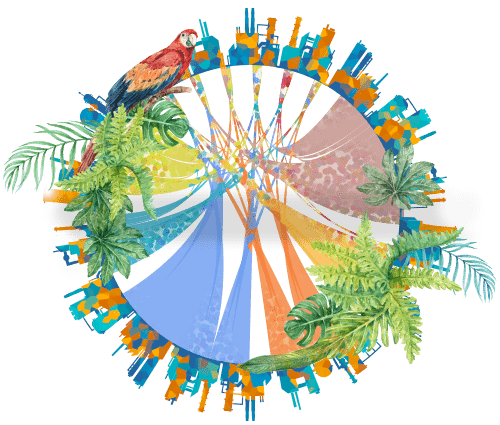

NbS Digital Dialogues
Virtual Event
7-9 July 2020
"What happened?
Welcome
Despite the challenges of COVID-19, the climate and biodiversity crises are ongoing. Transformative action to address these interrelated crises is needed now more than ever. To this end, on 7-9 July 2020 the Nature-based Solutions Initiative hosted a virtual event, NbS Digital Dialogues, to discuss each of four key guidelines for successful, sustainable nature-based solutions (NbS) outlined in www.nbsguidelines.info. Over 750 people registered from across the globe and tuned into a series of keynotes, panel discussions and poster sessions in which we debated the main challenges around the implementation, financing and governance of NbS, and how to overcome them. We also reflected on the role of NbS for economic recovery from COVID-19 across the world.
NbS Digital Dialogues served as a primer to the Nature-based Solutions Conference, now postponed to July 2022, with many of our speakers for the 2022 conference contributing to this virtual event as well.
Resources:
Summaries: written summaries of each session, containing key take-homes for research, practice and policy, are available for you to read and share.
Recordings: video recordings of all the sessions are available.
The posters from the event can be downloaded from the galleries below.
To keep up to date with the Nature-based Solutions Initiative, including news on the upcoming conference in 2021, you can sign up to our newsletter via our main website.
Programme
The event comprised three keynotes and six 75-minute panel sessions over three days. Sessions involved 4-5 short presentations, a facilitated panel discussion, Q&A sessions with our remote audience, and poster sessions. Our facilitators and speakers were world-leading experts from across science, policy and practice working at the nexus of climate change, biodiversity and development.
Keynote speakers
Keynotes were delivered at the start of days 1 and 2, and at the end of day 3. Each of our eminent speakers reflected on the role of nature-based solutions for sustainable development, post-covid-19, and what it will take to scale them up.
Watch the keynote talks here:
Complementary Speakers
Luc Bas, European Regional Director for the International Union for the Conservation of Nature (IUCN), reflected on the key messages emerging from Day 1 and discussed NbS from a European perspective. Watch here from 55:30.
Stewart Maginnis, Global Director of Nature-based Solutions Group and Director of Global Forest & Climate Change Programme at the IUCN spoke on Enabling a just and durable transition to sustainability: NbS tools and approaches to “building back better”. He also set the scene for Day 2. Watch here.
Karin Zaunberger, from the European Commission, reflected on the key messages emerging from talks on Day 2 and spoke about Investing in NbS for a resilient recovery. Watch here from 1:02:35.
Justin Adams, Executive Director of the Tropical Forest Alliance (WEF), welcomed us to Day 3 and set the scene for discussions on NbS finance and governance. Watch here.
Outputs
Outcomes from each session are now being synthesised in policy briefs targeted at the UN meetings late in 2020/early 2021 and will be made available to a wide audience through a creative outreach campaign.
NbS for climate change mitigation
Guiding principle 01: NbS are not a substitute for a rapid fossil fuel phase-out and must not delay urgent action to decarbonise our economies
Nature-based solutions for climate change mitigation are currently in the limelight, but uncertainties on the potential contribution of NbS to tackling climate change and serious concerns about trade-offs and unintended consequences remain. In this session, we discussed current understanding of the mitigation potential of NbS, highlighting their role in reducing peak warming and enabling long term cooling. We then discussed major issues around scaling up bioenergy, BECCS, intensifying agriculture, and afforestation including inappropriate tree-planting on naturally open ecosystems such as grasslands, savannas, and peatlands. Finally, we debated the moral hazard of promoting NbS at the expense of delaying fossil fuel emissions reductions.
We asked: Is biological offsetting of carbon emissions good or bad?
Speakers include
Key reading
- Griscom, B. W. et al. (2020). National mitigation potential from natural climate solutions in the tropics. Philosophical Transactions of the Royal Society B, 375, 20190126. https://doi.org/10.1098/rstb.2019.0126
- Griscom, B.W. et al. (2017) Natural climate solutions, Proceedings of the National Academy of Science 114, 11645– 11650. https://www.doi.org/10.1073/pnas.1710465114
- IPCC (2018). Global warming of 1.5°C. An IPCC Special Report on the impacts of global warming of 1.5°C above pre-industrial levels and related global greenhouse gas emission pathways, in the context of strengthening the global response to the threat of climate change, sustainable development, and efforts to eradicate poverty. Retrieved from: https://www.ipcc.ch/sr15/
- Lewis, S.L., C.E. Wheeler, E.T.A. et al. (2019) Restoring natural forest is the best way to remove atmospheric carbon. Nature 568, 25-28. https://www.doi.org/10.1038/d41586-019-01026-8.
- Seddon, N. et al. (2020). Understanding the value and limits of nature-based solutions to climate change and other global challenges. Philosophical Transactions of the Royal Society B, 375, 20190120. https://doi.org/10.1098/rstb.2019.0120
NbS in all ecosystems
Guiding principle 02: Successful, sustainable NbS involve the protection and/or restoration of a wide range of naturally occurring ecosystems on land and in the sea, not only forests
Currently, high-level multilateral pledges for nature focus on forests. In this session, we will highlight how other ecosystems provide important carbon storage services, help society adapt to climate change, are rich in biodiversity, and support the livelihoods of millions of people. We highlighted the vital role of drylands, freshwater, coastal and marine habitats in storing carbon and shielding humans from climate change impacts and promoting resilient landscapes that support livelihoods. In particular, we focused on how this knowledge can be harnessed in a landscape planning context to prioritize nature-based solutions.
We asked: How should ecosystems be prioritised for restoration and protection? Who should decide/or/through what modes of governance should these decisions be made?
Read the summary document: Successful, sustainable NbS involve the protection and restoration of a wide range of naturally occurring ecosystems on land and in the sea.
Speakers include
Key reading
- Arkema, K. K. et al. (2013). Coastal habitats shield people and property from sea-level rise and storms. Nature Climate Change, 3(10), 913-918. https://doi.org/10.1038/nclimate1944
- Barlow, J. et al. (2019). Clarifying Amazonia’s burning crisis. Global Change Biology. https://doi.org/10.1111/gcb.14872
- Bengtsson, J. et al. (2019). Grasslands—more important for ecosystem services than you might think. Ecosphere, 10, e02582. https://doi.org/10.1002/ecs2.2582
- Selig, E. R. et al. (2019). Mapping global human dependence on marine ecosystems. Conservation Letters, 12, e12617. https://doi.org/10.1111/conl.12617
- Martin, T. G., & Watson, J. E. (2016). Intact ecosystems provide the best defence against climate change. Nature Climate Change, 6, 122-124. https://doi.org/10.1038/nclimate2918
- Maxwell, S. L. et al. (2019). Degradation and forgone removals increase the carbon impact of intact forest loss by 626%. Science Advances, 5, eaax2546. https://doi.org/10.1126/sciadv.aax2546
- Veldman, J. W. et al. (2015). Where tree planting and forest expansion are bad for biodiversity and ecosystem services. BioScience, 65, 1011-1018. https://doi.org/10.1093/biosci/biv118
- Mcleod, E. et al. (2011). A blueprint for blue carbon: toward an improved understanding of the role of vegetated coastal habitats in sequestering CO2. Frontiers in Ecology and the Environment, 9, 552-560. https://doi.org/10.1890/110004
- Soto-Navarro, C. et al. (2020). Mapping co-benefits for carbon storage and biodiversity to inform conservation policy and action. Philosophical Transactions of the Royal Society B, 375(1794), 20190128. https://doi.org/10.1098/rstb.2019.0128
- Tan, L. et al. (2019). Conversion of coastal wetlands, riparian wetlands, and peatlands increases greenhouse gas emissions: A global meta‐analysis. Global Change Biology. https://doi.org/10.1111/gcb.14933
- Van Coppenolle, R., & Temmerman, S. (2020). Identifying global hotspots where coastal wetland conservation can contribute to nature-based mitigation of coastal flood risks. Global and Planetary Change, 103125. https://doi.org/10.1016/j.gloplacha.2020.10312
- Watson, J. E. et al. (2018). The exceptional value of intact forest ecosystems. Nature Ecology & Evolution, 2, 599-610. https://doi.org/10.1038/s41559-018-0490-x
- EcoShape (2018). Houtrib Dike Pilot Project Summary and Business case
- de Vriend et al. (2014). ‘Building with nature’: the new Dutch
approach to coastal and river works. Proceedings of the Institution of Civil Engineers-Civil Engineering, 167(1), 18-24. https://doi.org/10.1680/cien.13.00003 - FAO (2019). Trees, forests and land use in drylands: the first global assessment – Full report. FAO Forestry Paper No. 184. Rome.. http://www.fao.org/documents/card/en/c/ca7148en/
- Berrahmouni, N. et al. (2015). Global guidelines for the restoration of degraded forests and landscapes in drylands: Building resilience and benefiting livelihoods. Forestry Paper 175. Rome, FAO. 149 pp. http://www.fao.org/3/a-i5036e.pdf
- Sacande M. and Berrahmouni N. (2016). Community participation and ecological criteria for selecting species and restoring natural capital with native species in the Sahel. Restoration Ecology. DOI. 10.1111/ rec.12335
- Berrahmouni N. et al. (2016). Building Africa’s Great Green Wall : Restoring degraded drylands for stronger and more resilient communities. Rome, FAO. Rome. http://www.fao.org/3/a-i6476e.pdf
- Sacande M. et al. (2020). Restoration in Action Against Desertification. A manual for large-scale restoration to support rural communities’ resilience in Africa’s Great Green Wall. Rome, FAO. 92 pp. http://www.fao.org/3/ca6932en/ca6932en.pdf. For further information: www.fao.org/in-action/action-against-desertification
Posters
| Name | Affiliation | Poster title | File |
|---|---|---|---|
| Tom Powell | University of Exeter | Carbon sequestration and regreening by Kenyan smallholder farmers | Download poster |
| Trisha Gopalakrishna | University of Oxford | Reforesting in India for climate change mitigation without compromising native savannahs | Download poster |
| Kevin Mganga | University of Helsinki | Potential of indigenous grasses for the restoration of degraded African drylands | Download poster |
| Thomas Murphy | University of Plymouth, Moor Trees | Natural and assisted regeneration of oak in UK | Download poster |
| Diego Navarrete | The Nature Conservancy | Mitigation potential of Natural Climate Solutions in Colombia | Download poster |
NbS with, by and for people
Guiding principle 03: Successful, sustainable NbS are implemented with engagement and consent of Indigenous Peoples and local communities, apply robust social safeguards, and are designed to build human capacity to adapt to climate change
What makes the NbS framing different and powerful? The answer is people. In this session, we will discuss how Indigenous Peoples and local communities drive transformative NbS. With reference to diverse examples from across the globe, we discussed why local knowledge and engagement, leadership and collective action are central to nature-based solutions for climate change and highlighted the importance of recognising, respecting and upholding people’s livelihoods and rights.
We asked: How can Indigenous Peoples and local communities be empowered to engage with other stakeholders and drive the delivery of NbS? What structures enable such agency to emerge?
Read the summary document: Empowering Indigenous People and local communities with NbS
Speakers include
Key reading
- Fa, J. E. et al. (2019). Importance of Indigenous Peoples’ lands for the conservation of Intact Forest Landscapes. Frontiers in Ecology and the Environment. https://doi.org/10.1002/fee.2148
- Garnett, S. T. et al. (2018). A spatial overview of the global importance of Indigenous lands for conservation. Nature Sustainability, 1, 369. https://doi.org/10.1038/s41893-018-0100-6
- Krasny, M. E., Russ, A., Tidball, K. G., & Elmqvist, T. (2014).
Civic ecology practices: Participatory approaches to generating and
measuring ecosystem services in cities. Ecosystem Services. https://doi.org/10.1016/j.
ecoser.2013.11.002 - Pinho, P. F., Marengo, J. A., & Smith, M. S. (2015). Complex
socio-ecological dynamics driven by extreme events in the Amazon.
Regional Environmental Change. https://doi.org/10.1007/
s10113-014-0659-z - Lavorel, S., Locatelli, B., Colloff, M. J., & Bruley, E. (2020).
Co-producing ecosystem services for adapting to climate change.
Philosophical Transactions of the Royal Society B: Biological
Sciences. https://doi.org/10.1098/rstb.
2019.0119 - Roberts, D., Boon, R., Diederichs, N., Douwes, E., Govender, N.,
Mcinnes, A., … Spires, M. (2012). Exploring ecosystem-based adaptation
in Durban, South Africa: “learning-by-doing” at the local government
coal face. Environment and Urbanization, 24(1), 167–195. https://doi.org/10.1177/
0956247811431412 - Walker, W. S. et al. (2020). The role of forest conversion, degradation, and disturbance in the carbon dynamics of Amazon indigenous territories and protected areas. Proceedings of the National Academy of Sciences, 117, 3015–3025. https://doi.org/10.1073/pnas.1913321117
- Westholm, L. 2016. Fruits from the forest and the fields: forest conservation policies andintersecting social inequalities in Burkina Faso’s REDD+ program. International Forestry Review 18(4):511–521.
Biodiversity and NbS
Guiding principle 04: Successful, sustainable NbS sustain, enhance or support biodiversity
Biodiversity plays a vital role in the healthy functioning and resilience of ecosystems. It secures the flow of essential services, reduces trade-offs among them, and supports human capacity to adapt to climate change. In this session, we highlighted the contribution of biodiversity to climate mitigation and/or adaptation in the context of protecting intact ecosystems, restoring landscapes and sustaining agriculture. Then we discussed how knowledge of biodiversity’s importance could better inform the policy and practice of NbS. We will discuss interlinkages between the CBD’s Global Biodiversity Framework and the UNFCCC’s Paris Agreement and reflected on how best to overcome key obstacles to biodiversity-based policy targets.
We asked: as we take NbS to scale, how do we ensure that they support biodiversity and are resilient in a rapidly changing world?
Read the summary document: Biodiversity as a fundamental property and a valuable outcome of NbS.
Speakers include
Key reading
- Andersson, K. et al. (2016). More trees, more poverty? The socioeconomic effects of tree plantations in Chile, 2001–2011. Environmental Management, 57, 123-136. https://doi.org/10.1007/s00267-015-0594-x
- Cardinale, B. J. et al. (2012). Biodiversity loss and its impact on humanity. Nature, 486, 59-67. https://doi.org/10.1038/nature11148
- Castano-Villa, G. J. et al. (2019). Differential effects of forestry plantations on bird diversity: A global assessment. Forest Ecology and Management, 440, 202-207. https://doi.org/10.1016/j.foreco.2019.03.025
- Global Commission on Adaptation (2019). Adapt Now: A Global Call for Leadership on Climate Resilience. Retrieved from: https://gca.org/global-commission-on-adaptation/report
- Hutchison, C. et al. (2018). Effect of diversity on growth, mortality, and loss of resilience to extreme climate events in a tropical planted forest experiment. Scientific Reports, 8, 1-10. https://doi.org/10.1038/s41598-018-33670-x
- IPBES (2020). Summary for policymakers of the global assessment report on biodiversity and ecosystem services of the Intergovernmental Science-Policy Platform on Biodiversity and Ecosystem Services. Retrieved from: https://ipbes.net/global-assessment-report-biodiversity-ecosystem-services
- Jactel, H. et al. (2017). Tree diversity drives forest stand resistance to natural disturbances. Current Forestry Reports, 3, 223-243. https://doi.org/10.1007/s40725-017-0064-1
- Liu, Y., & Li, Y. (2019). Synergy and trade-off between carbon sequestration and soil water balance: impact of revegetation choices. Environmental Earth Sciences, 78, 651. https://doi.org/10.1007/s12665-019-8646-9
- Osuri, A. M. et al. (2019). Greater stability of carbon capture in species-rich natural forests compared to species-poor plantations. Environmental Research Letters. https://doi.org/10.1088/1748-9326/ab5f75
Posters
| Name | Affiliation | Poster title | File |
|---|---|---|---|
| Claire Barrett-Mold | Environment Agency, UK | Leeds Flood Alleviation Scheme: Natural Flood Management | Download poster |
| Annie Welden | University of Oxford | Working with Beavers: Possibilities for multispecies collaborations in NbS infrastructures | Download poster |
| Gerd Lupp | Technical University of Munich | Stakeholder participation through Living Labs in PHUSICOS Planning, co-designing and implementing nature-based solutions in rural mountain areas | Download poster |
| Carl Cyrus Anderson | University of Glasgow | A literature review on the “How?” and the “Why?” of increasing public acceptanceof NbS | Download poster |
| Marina Melanidis | University of British Columbia | Successes, challenges, and new directions for addressing social outcomes in nature-based solutions | Download poster |
| Linjun Xie | Durham University | Conserve, restore and thrive: How cities are working with nature-based solutions for biodiversity? | Download poster |
Financing NbS
Overcoming obstacles and mobilizing investments for successful, sustainable NbS
To mobilize large and sustainable flows of finance to nature-based solutions we need to break out of existing paradigms. In this session, we discussed what this paradigm-shift looks like across companies and industries, financial institutions, private investors, governments, multilateral agencies and the global community.
We asked: what role can and should nature-based solutions play in enabling a green recovery post-Covid19?
Read the summary here: Financing NbS: Overcoming obstacles and mobilizing investments for successful, sustainable NbS.
Speakers include
Key reading
- Keeler, B.L., Hamel, P., McPhearson, T., Hamann, M.H., Donahue, M.L., Prado, K.A.M., Arkema, K.K., Bratman, G.N., Brauman, K.A., Finlay, J.C. and Guerry, A.D., 2019. Social-ecological and technological factors moderate the value of urban nature. Nature Sustainability, 2(1), pp.29-38. https://doi.org/10.1038/s41893-018-0202-1
- Frantzeskaki, N., McPhearson, T., Collier, M.J., Kendal, D., Bulkeley, H., Dumitru, A., Walsh, C., Noble, K., Van Wyk, E., Ordóñez, C. and Oke, C., 2019. Nature-based solutions for urban climate change adaptation: linking science, policy, and practice communities for evidence-based decision-making. BioScience, 69(6), pp.455-466. https://doi.org/10.1093/biosci/biz042
- Andersson, E., Langemeyer, J., Borgström, S., McPhearson, T., Haase, D., Kronenberg, J., Barton, D.N., Davis, M., Naumann, S., Röschel, L. and Baró, F., 2019. Enabling green and blue infrastructure to improve contributions to human well-being and equity in urban systems. BioScience, 69(7), pp.566-574. https://doi.org/10.1093/biosci/biz058
Governing NbS
Overcoming the governance challenges of taking Nature-based Solutions to scale
Nature-based solutions depend on innovative and effective governance at local, national, and transnational scales. In this session, we will compare the successes and challenges in the governance of nature-based solutions across a diverse array of countries facing different challenges for sustainable development and we will explore which models can be replicated and scaled up. Looking ahead to the CBD COP15 and UNFCCC COP26 in Glasgow in 2021, we discussed what we can learn from these experiences to further catalyse and scale-up effective NbS.
We asked: What are some key innovations or successes in NbS governance? What can COP26 and/or COP15 do to support success at the national level?
Read the summary document: Overcoming the governance challenges of taking NbS to scale.
Speakers include
Posters
| Name | Affiliation | Poster title | File |
|---|---|---|---|
| Mario Brillinger | Leibniz University Hannover | Beliefs and values on the suitability of different river restoration options as NbS: insights from participatory Multi-Criteria Analysis | Download poster |
| Anika Terton | International Institute for Sustainable Development | Building resilience with nature: ecosystem-based adaptation in National Adaptation Plan (NAP) processes | Download poster |
| Sareh Moosavi | Universite Libre de Bruxelles | Creating nature-based cities: synergies of interdisciplinary planning & design | Download poster |
| Alison Fairbrass | University College London | Measuring progress towards achieving the environmental dimensions of the SDGs | Download poster |
| Danilo Ignacio Urzedo | University of Sydney | The global production network for ecosystem services: the emergent governance of landscape restoration in the Brazilian Amazon | Download poster |
| Mark Hirons | University of Oxford | Governing Natural Climate Solutions: prospects and pitfalls | Download poster |
Additional posters
| Name | Affiliation | Poster title | File |
|---|---|---|---|
| Fabio Cresto Aleina | WWF-Smart Coasts Project-Regional Working Group | Smart Coasts: helping the Mesoamerican Reef to face climate change | Download poster |
| Sindhuja Janakiraman | Delft University of Technology | Landscape infrastructure solutions for resilient, equitable and adaptable socio-ecological systems in Capetown | Download poster |
| Alexia Semeraro | Flanders Research Institute for Agriculture, Fisheries and Food | Nature-based solutions for coastal zone management: biogenic reef concepts | Download poster |
| Nivedita Mani | Gorakhpur Environmental Action Group | Conserving peri-urban ecosystems for building urban resilience | Download poster |
| Ingrid Schulte | Humbolt University of Berlin | Towards the implementation of Natural Climate Solutions: a systematic review and evidence mapping | Download poster |
| Sylvanus Doe | GeoSustainability Consulting | Integrating eco-entrepreneural model into nature-based solutions for sustainable oyster conservation | Download poster |
| Laurice Ereifej | WWF Central and Eastern Europe | Living Danube Partnership | Download poster |
| Barbara Schroeter | Leibniz Centre for Agricultural Landscape Research | From concept to practice: nature-based solutions in online case study collections | Download poster |
| Juliet Millican | Re-alliance | The value of nature-based solutions in humanitarian and development response | Download poster |
| Michael Loupis | Innovative Technologies Centre | Addressing Governance Issues in NbS Implementation through a Novel Co-creation Process | Download poster |
| James Oyesolaa | Ecosystem Based Adaptation for Food Security Assembly Nigeria | Cocoa agroforestry in Nigeria | Download poster |
| Udo Schwarzer | IOB International organization for natural bathing waters | Biological swimming pool | Download poster |

































